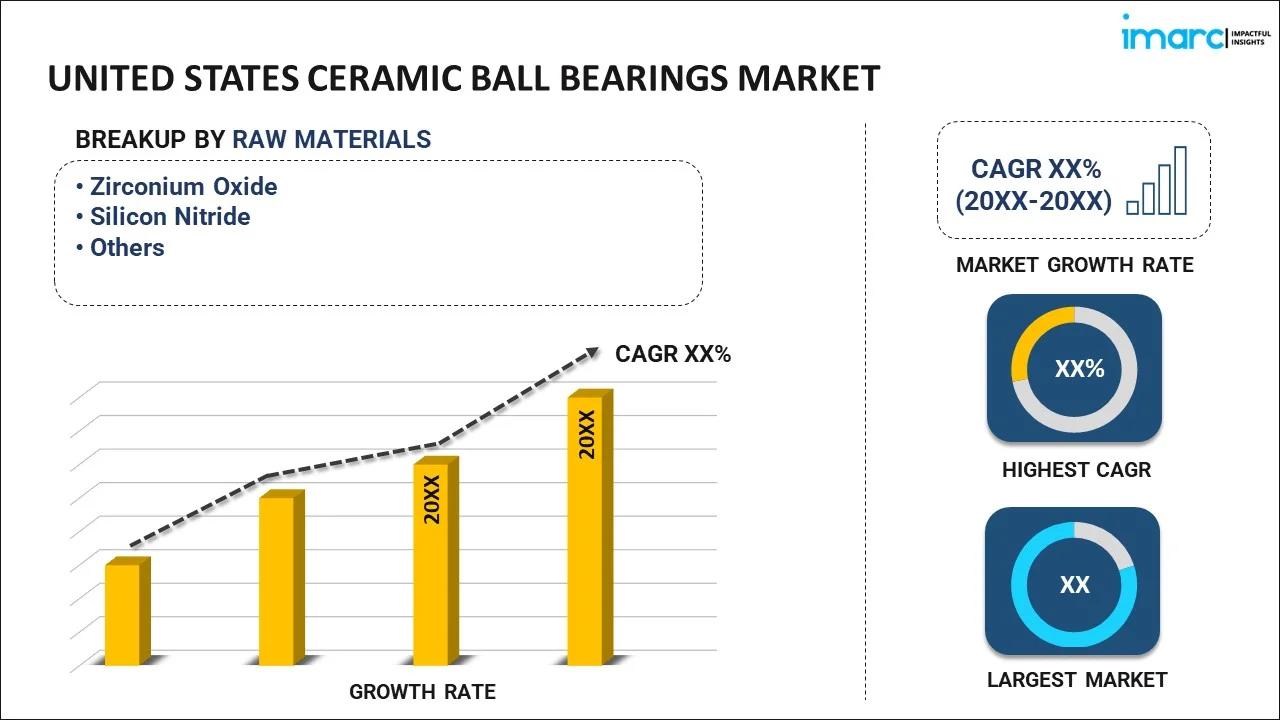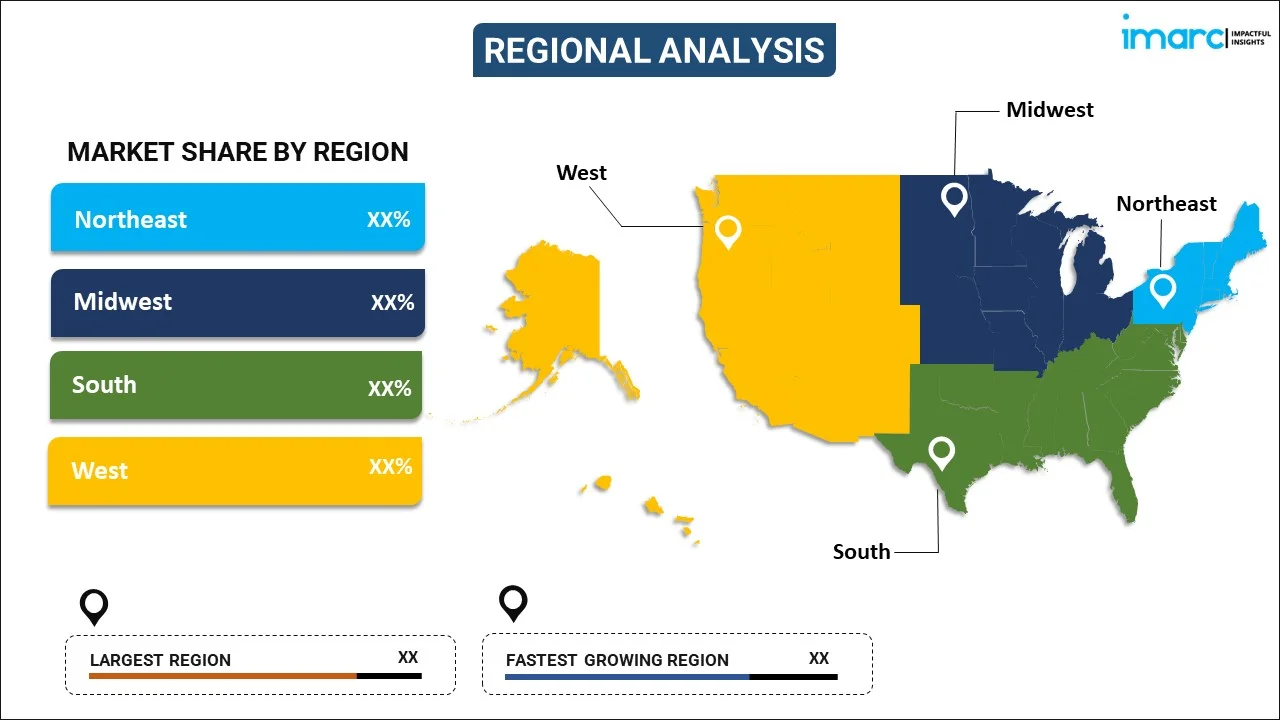
United States Ceramic Ball Bearings Market Report by Raw Material (Zirconium Oxide, Silicon Nitride, and Others), Product Type (Hybrid Ceramic Ball Bearings, Full Ceramic Ball Bearings), Application (Electric Motors, Automobile, Under Water Equipment, Laboratory Equipment, Aerospace, and Others), and Region 2025-2033
Market Overview:
The United States ceramic ball bearings market size reached USD 409.9 Million in 2024. Looking forward, IMARC Group expects the market to reach USD 798.7 Million by 2033, exhibiting a growth rate (CAGR) of 7.31% during 2025-2033.
|
Report Attribute
|
Key Statistics
|
|---|---|
|
Base Year
|
2024
|
|
Forecast Years
|
2025-2033
|
|
Historical Years
|
2019-2024
|
|
Market Size in 2024
|
USD 409.9 Million |
|
Market Forecast in 2033
|
USD 798.7 Million |
| Market Growth Rate 2025-2033 | 7.31% |
A ceramic ball bearing refers to an antifriction ball constructed entirely of ceramic material. They are made of either silicon nitride (Si3N4), zirconium oxide (ZrO2) or silicon carbide (SiC). Ceramic ball bearings are of two types’ viz. hybrid ceramic ball bearing and full ceramic ball bearing. In full ceramic ball bearings, all the bearing components are made of silicon nitride ceramic. However, in ceramic hybrid ball bearing only balls are made of silicon nitride ceramic and the inner race and outer race are made of steel. They offers various advantageous properties including longer service life, lower friction resistance, higher seizure resistance, higher corrosion resistance, higher rigidity, higher temperature resistance, lightweight, etc.
The United States is currently witnessing a trend of rebounding productions of motor vehicles and a healthy investment environment. Moreover, the market is also being catalyzed by the increasing demand of wind turbines. In the United States, the renewable energy market is likely to grow over the next few years with a significant growth expected to come from wind energy. Additionally, rising demand of ceramic ball bearings in electric motors, lab equipment and the aerospace industry is also creating a positive impact on the growth of the ceramic ball bearing market.
Key Market Segmentation:
IMARC Group provides an analysis of the key trends in each sub-segment of the United States ceramic ball bearings market report, along with forecasts at the country and regional level from 2025-2033. Our report has categorized the market based on raw material, product type and application.
Breakup by Raw Material

- Zirconium Oxide
- Silicon Nitride
- Others
Breakup by Product Type
- Hybrid Ceramic Ball Bearings
- Full Ceramic Ball Bearings
Breakup by Application
- Electric Motors
- Automobile
- Under Water Equipment
- Laboratory Equipment
- Aerospace
- Others
Breakup by Region

- Northeast
- Midwest
- South
- West
Value Chain Analysis
Key Drivers and Challenges
Porters Five Forces Analysis
PESTEL Analysis
Government Regulations
Competitive Landscape
- Competitive Structure
- Key Player Profiles
Report Coverage:
| Report Features | Details |
|---|---|
| Base Year of the Analysis | 2024 |
| Historical Period | 2019-2024 |
| Forecast Period | 2025-2033 |
| Units | Million USD |
| Segment Coverage | Raw Material, Product Type, Application, Region |
| Region Covered | Northeast, Midwest, South, West |
| Customization Scope | 10% Free Customization |
| Post-Sale Analyst Support | 10-12 Weeks |
| Delivery Format | PDF and Excel through Email (We can also provide the editable version of the report in PPT/Word format on special request) |
Key Questions Answered in This Report
The United States ceramic ball bearings market was valued at USD 409.9 Million in 2024.
We expect the United States ceramic ball bearings market to exhibit a CAGR of 7.31% during 2025-2033.
The continuous replacement of conventional stainless ball bearings with ceramic-based alternatives in agitators, grinding equipment, rotational devices, etc., is currently driving the United States ceramic ball bearings market.
The sudden outbreak of the COVID-19 pandemic had led to the implementation of stringent
lockdown regulations across the nation resulting in temporary closure of numerous manufacturing units for ceramic ball bearings.
Based on the raw material, the United States ceramic ball bearings market can be categorized into zirconium oxide, silicon nitride, and others. Among these, zirconium oxide exhibits a clear
dominance in the market.
Based on the product type, the United States ceramic ball bearings market has been segmented into hybrid ceramic ball bearings and full ceramic ball bearings. Currently, hybrid ceramic ball bearings represent the largest market share.
Based on the application, the United States ceramic ball bearings market can be bifurcated into
electric motors, automobile, under water equipment, laboratory equipment, aerospace, and others. Among these, the automobile sector currently accounts for the majority of the total market share.
On a regional level, the market has been classified into Northeast, Midwest, South, and West, where South currently dominates the market.
Need more help?
- Speak to our experienced analysts for insights on the current market scenarios.
- Include additional segments and countries to customize the report as per your requirement.
- Gain an unparalleled competitive advantage in your domain by understanding how to utilize the report and positively impacting your operations and revenue.
- For further assistance, please connect with our analysts.
 Inquire Before Buying
Inquire Before Buying
 Speak to an Analyst
Speak to an Analyst
 Request Brochure
Request Brochure
 Request Customization
Request Customization




.webp)




.webp)












